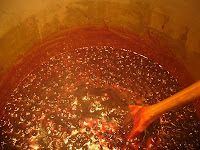So our half-bushel of cucumbers and abundant green beans and zucchini got the pickling treatment. Adding a vinegar-water-salt (and sometimes sugar) solution to sterilized jars with spices and vegetables and then processing the jars in boiling water for a minimum of 10 minutes ensures safe vegetables through the winter months and spring food gap. Here's our process:
 (1) Wash vegetables and cut to size so they fit into your sterilized jars with some room to spare at the top (it's important that all parts of the vegetable come into contact with the pickling solution). Seed cucumbers if you prefer.
(1) Wash vegetables and cut to size so they fit into your sterilized jars with some room to spare at the top (it's important that all parts of the vegetable come into contact with the pickling solution). Seed cucumbers if you prefer.(2) Bring to boil equal portions water and vinegar with 1/4 cup salt for every 5 cups of liquid.
(3) Pack sterilized jars with a garlic clove, 1/2 jalapeno, a few coriander seeds, a few peppercorns, a hefty pinch of mustard seeds and dill flowers. Pack in vegetables.
 (4) Pour boiling pickling solution into jars, leaving about 1/2 inch of space at the top. Be sure all vegetables are covered with the solution. Seal tightly.
(4) Pour boiling pickling solution into jars, leaving about 1/2 inch of space at the top. Be sure all vegetables are covered with the solution. Seal tightly.(5) Process in boiling water bath for at least 10 minutes (we processed the cucumber pickles for 20 minutes, as suggested by The Joy of Cooking).
 (6) Leave jars to pickle for at least 1 week before opening. Store at room temperature.
(6) Leave jars to pickle for at least 1 week before opening. Store at room temperature.





























